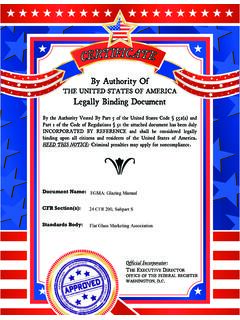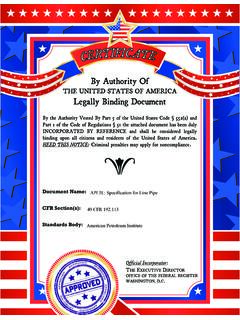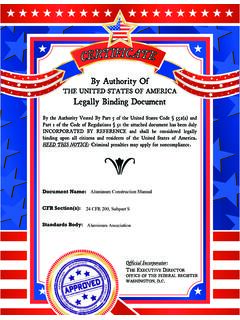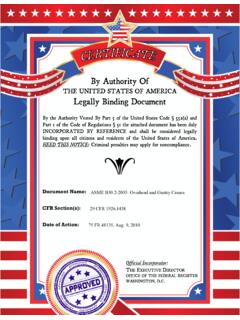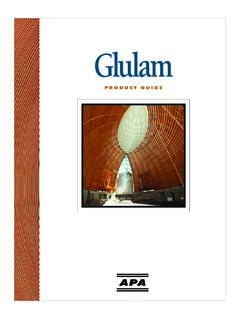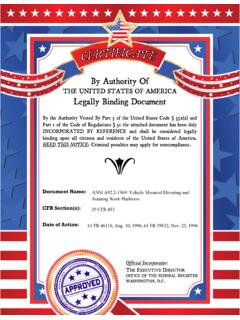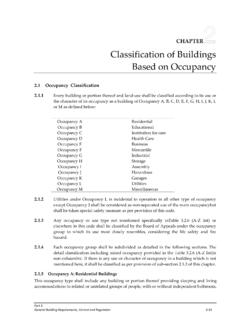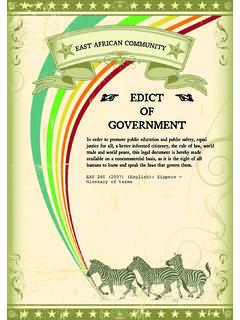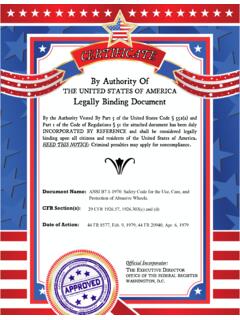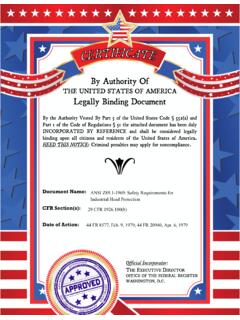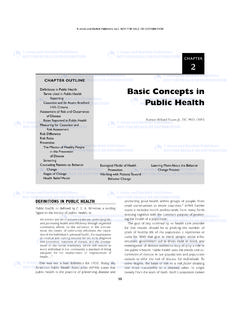Transcription of By Authority Of - Public.Resource.Org
1 By Authority OfTHE UNITED STATES OF AMERICAL egally Binding DocumentBy the Authority Vested By Part 5 of the United States Code 552(a) and Part 1 of the Code of Regulations 51 the attached document has been duly INCORPORATED BY REFERENCE and shall be considered legally binding upon all citizens and residents of the United States of America. HEED THIS NOTICE: Criminal penalties may apply for noncompliance. Official Incorporator:THE EXECUTIVE DIRECTOROFFICE OF THE FEDERAL REGISTERWASHINGTON, Name: CFR Section(s): Standards Body: eRecommended Practice for Analysis, Design, Installation, and Testing of Basic Surface Safety Systems for Offshore Production Platforms Upstream Segment API RECOMMENDED PRACTICE 14C SEVENTH EDITION, MARCH 2001 REAFFIRMED: MARCH 2007 Reproduced By IHS With The Permission Of API Under Royalty Agreement SPECIAL NOTES API publications necessarily address problems of a general nature.
2 With respect to partic-ular circumstances, local, state, and federal laws and regulations should be reviewed. API is not undertaking to meet the duties of employers, manufacturers, or suppliers to warn and properly train and equip their employees, and others exposed, concerning health and safety risks and precautions, nor undertaking their obligations under local, state, or fed-erallaws. Information concerning safety and health risks and proper precautions with respect to par-ticular materials and conditions should be obtained from the employer, the manufacturer or supplier of that material, or the material safety data sheet. Nothing contained in any API publication is to be construed as granting any right, by implication or otherwise, for the manufacture, sale, or use of any method, apparatus, or prod-uct covered by letters patent.
3 Neither should anything contained in the publication be con-strued as insuring anyone against liability for infringement ofletters patent. Generally, API standards are reviewed and revised, reaffinned, or withdrawn at least every five years. Sometimes a one-time extension of up to two years will be added to this review cycle. This publication will no longer be in effect five years after its publication date as an operative API standard or, where an extension has been granted, upon republication. Status of the publication can be ascertained from the API Upstream Segment [telephone (202) 682-8000]. A catalog of API publications and materials is published annually and updated quar-terly by API, 1220 L Street, , Washington, 20005. This document was produced under API standardization procedures that ensure appropri-ate notification and participation in the developmental process and is designated as an API standard.
4 Questions concerning the interpretation of the content of this standard or com-ments and questions concerning the procedure> under which this standard was developed should be directed in writing to the general manager of the Upstream Segment, American Petroleum Institute, 1220 L Street, , Washington, 20005. Requests for pennission to reproduce or translate all or any part of the material published herein should also be addressed to the general manager. API standards are published to facilitate the broad availability of proven, sound engineer-ing and operating practices. These standards are not intended to obviate the need for apply-ing sound engineering judgment regarding when and where these standards should be utilized. The fonnulation and publication of API standards is not intended in any way to inhibit anyone from using any other practices.
5 Any manufacturer marking equipment or materials in conformance with the marking requirements of an API standard is solely responsible for complying with all the applicable requirements of that standard. API does not represent, warrant, or guarantee that such prod-ucts do in fact conform to the applicable API standard. All rights reserved. No part of this work may be reproduced, stored in a retrieval system, or transmitted hy any means, electronic, mechanical, photocopying, recording, or otherwise, wi/hout prior written permission/rom the publisher. Contact the Publisher, API Publishing Services, 1220 L Street, N. W, Washington, 20005. Copyright 2001 American Petroleum Institute FOREWORD This standard was developed as an API recommended practice under the jurisdiction of the API Upstream Segment Executive Committee on Drilling and Production Operations.
6 This recommended practice presents a standardized method to design, install, and test sur-face safety systems on offshore production platforms and is intended for use by design engi-neers and operating personnel. Recognized systems analysis methods are used to develop requirements for a safety system and procedures are included to document the safety system and verify conformance with the recommended practice. Other API recommended practices for safety and antipollution systems used in offshore oil and gas production include the following: RP 14E Design and Installation of Offshore Production Platform Piping Systems RP 14F Design and Installation of Electrical Systems for Fixed and Floating shore Petroleum Facilities for Unclassified and Class I, Division I and Division 2 Locations RP 14G Fire Prevention and Control on Open Type Ol!
7 ~'hore Production Plat-forms RP 141 Design and Hazards Analysisfor Offshore Production facilities RP 75 Development of a Safety and Environmental Management Program for Outer Continental She/f(OCS) Operations and Facilities API publications may be used by anyone desiring to do so. Every effort has been made by the Institute to assure the accuracy and reliability of the data contained in them; however, the Institute makes no representation, warranty, or guarantee in connection with this publication and hereby expressly disclaims any liability or responsibility for loss or damage resulting from its use or for the violation of any federal, state, or municipal regulation with which this publication may conflict. Suggested revisions are invited and should be submitted to the general manager, Ustream Segment, American Petroleum Institute, 1220 L Street, N.
8 W., Washington, 20005. This publication shall become effective on the date printed on the cover but may be used voluntarily from the date of distribution. iii CONTENTS Page 1. GENERAL .. Introduction .. Scope .. Organization of Technical Content.. Government Codes, Rules, and Regulations.. I Industry Codes, Standards, and Recommended Practices .. 2 Metric Conversions.. 3 2. SAFETY DEVICE SYMBOLS AND IDENTIFICATION .. 3 Introduction .. 3 Functional Device Identification .. 3 Symbols .. 3 Component Identification .. 3 Example Identification .. 3 3. INTRODUCTION TO SAFETY ANALYSIS AND SYSTEM DESIGN .. 7 Purpose and Objectives .. 7 Safety Flow Chart.. 7 Modes of Safety System Operation .. 7 Premises for Basic Analysis and Design.
9 7 4. PROTECTION CONCEPTS AND SAFETY ANALYSIS .. 8 Introduction .. 8 Protection Concepts.. 8 Safety Analysis .. 15 Analysis and Design Procedure Summary.. 16 APPENDIX A PROCESS COMPONENT ANALYSIS .. 17 APPENDIX B ANALYSIS TABLES .. 55 APPENDIX C SUPPORT SYSTEMS .. 63 APPENDIX D TESTING AND REPORTING PROCEDURES .. 69 APPENDIX E EXAMPLES OF SAFETY ANALYSIS FLOW DIAGRAM AND SAFETY ANALYSIS FUNCTION EVALUATION (SAFE) CHART .. 75 APPENDIX F TOXIC GAS SECTION .. 87 APPENDIX G DEFINITIONS .. 91 Figures 2-1 Examples of Safety Device Identification .. 5 3-1 Safety Flow Chart-Offshore Production Facility .. 9 Recommended Safety Devices-Wellhead Flow Lines .. 19 Safety Devices-Underwater Wellhead Flow Lines .. 20 Safety Devices-Satellite Well.
10 21 A-2 Recommended Safety Devices-Wellhead Injection Lines .. 23 A-3 Recommended Safety Devices-Headers .. 25 A-4 Recommended Safety Devices-Pressure Vessel .. 27 A-5 Recommended Safety Devices-Atmospheric Vessels .. 30 Recommended Safety Devices-Typical Fired Vessel (Natural Draft) .. 34 Safety Devices-Typical Fired Vessel (Forced Draft) .. 35 Safety Devices-Exhaust Heated Component .. 36 v Page Recommended Safety Devices-Pipeline Pump .. 41 Safety Devices-Glycol Powered Glycol Pump .. 42 Safety Devices-Other Pump .. " .. 43 A-8 Recommended Safety Devices-Compressor Unit .. 46 A-9 Recommended Safety Devices-Pipelines .. 49 A-IO Recommended Safety Devices-Heat Exchangers (Shell-Tube) .. 52 B-1 Safety Analysis Function Evaluation Chart (SAFE).
